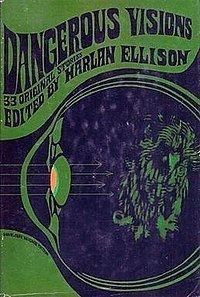8.4 /10 1 Votes8.4
Country United States Pages 544 | 4.2/5 Goodreads Language English Publication date 1967 Originally published 1967 Page count 544 | |||||||||||||||||||||||||||||||||
 | ||||||||||||||||||||||||||||||||||
Genres Anthology, Fiction, Science Fiction Similar Harlan Ellison books, Science Fiction books | ||||||||||||||||||||||||||||||||||
The exploited dangerous visions
Dangerous Visions (ISBN 0-425-06176-0) is a science fiction short story anthology edited by Harlan Ellison, published in 1967.
Contents
A path-breaking collection, Dangerous Visions helped define the New Wave science fiction movement, particularly in its depiction of sex in science fiction. Writer/editor Al Sarrantonio writes how Dangerous Visions "almost single-handedly [...] changed the way readers thought about science fiction."
Contributors to the volume included 20 authors who had won, or would win, a Hugo, Nebula, World Fantasy, or BSFA award, and 16 with multiple such awards. Ellison introduced the anthology both collectively and individually while authors provided afterwords to their own stories.
Awards and nominations
The stories and the anthology itself were nominated for and received many awards. "Gonna Roll the Bones" by Fritz Leiber received both a Hugo Award and a Nebula Award for Best novelette, whilst Philip K. Dick's submission "Faith of Our Fathers" was a nominee for the Hugo in the same category. Philip José Farmer tied for the Hugo Award for Best Novella for "Riders of the Purple Wage". Samuel R. Delany won the Nebula for Best Short Story for "Aye, and Gomorrah..." Harlan Ellison received a special citation at the 26th World SF Convention for editing "the most significant and controversial SF book published in 1967."
Sequels
The popular collection was followed by an even larger 1972 sequel, Again, Dangerous Visions. The projected third collection, The Last Dangerous Visions, was started, but controversially remains unpublished. The final book has become something of a legend as science fiction's most famous unpublished book. It was originally announced for publication in 1973, but other work demanded Ellison's attention and the anthology has not seen print to date. He has come under criticism for his treatment of some writers who submitted their stories to him, whom some estimate to number nearly 150 (and many of whom have died in the ensuing more than four decades since the anthology was first announced). In 1993 Ellison threatened to sue New England Science Fiction Association (NESFA) for publishing "Himself in Anachron", a short story written by Cordwainer Smith and sold to Ellison for the book by his widow, but later reached an amicable settlement. British SF author Christopher Priest critiqued Ellison's editorial practices in a widely disseminated article titled "The Book on the Edge of Forever". Priest documented a half-dozen instances in which Ellison promised TLDV would appear within a year of the statement, but did not fulfill those promises. Ellison has a record of fulfilling obligations in other instances, including to writers whose stories he solicited, and has expressed outrage at other editors who have displayed poor practices.
Contents
Illustrations by Leo and Diane Dillon accompany each short story.
